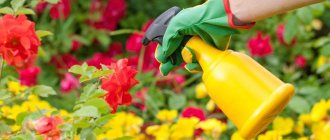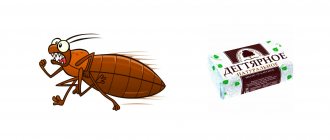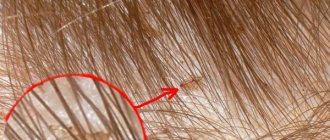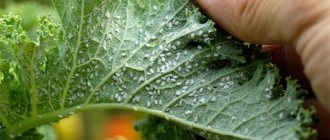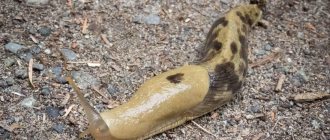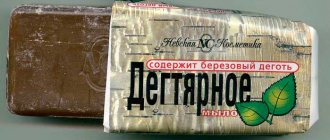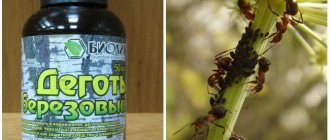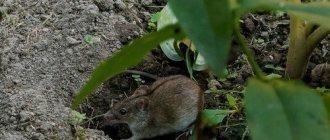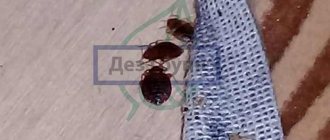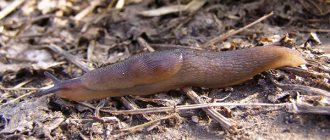Tar soap in the garden: unusual uses
The chemical industry offers gardeners more and more new preparations to protect plants from pests and diseases. But often the simplest, inexpensive and long-known means, always at hand, can very effectively solve country problems. One of these common resources is tar soap.
Tar soap
Its special properties come from the fact that it contains birch tar. There is an interesting and useful article on our website about this unique substance. Birch tar will always help out: 18 unexpected uses. However, in gardening, not only tar in its pure form is successfully used, but also ordinary tar soap, sold in any store.
Repelling insect pests
The persistent specific smell of tar is not to the liking of many insects. This fact is taken as the basis for the preparation of insecticidal agents. For further use, the soap must first be grated on a coarse grater - the result is brown shavings.
Tar soap shavings
In indoor floriculture
If you notice that midges have appeared in the soil of a houseplant, you can scare them away with shavings of tar soap. To do this, just sprinkle a little grated soap on the surface of the soil, and its smell will repel insects.
Tar soap will help repel midges
In the garden
To prepare a solution for treating garden and vegetable plants, first pour the soap shavings obtained from rubbing 2 bars of soap into 2 liters of warm water and stir until dissolved. The result is a thick liquid tar soap. It can be stored in bottles and used as needed.
We prepare a concentrate from liquid soap in the proportion of 1 liter per 5 liters of water. Then pour 1 liter of concentrate into a 10-liter watering can and top it up with water. Stir and pour over the plants through a diffuser.
Dilute the concentrate with water
This way you can get rid of aphids, onion and carrot flies, weevils, cabbage whites, codling moths, even the Colorado potato beetle cannot stand the smell of tar. However, there is an important limitation: you should not treat plants with solutions based on tar soap during flowering , since beneficial pollinating insects will also fly around your plantings.
Our regular author Tatyana (Tula region) has prepared a video in which she tells and shows how to prepare a solution based on tar soap for treating plants, and also shares other ways to use this product in the garden.
Do you use tar soap in the garden? Share your experience in the comments, tell other summer residents how this simple remedy works in your country house.
Source
How to use tar soap in the garden
Since ancient times, people have used the wonderful properties of tar for a variety of purposes. Several centuries ago, our ancestors came to the conclusion that solutions that contain it protect gardens and vegetable gardens from pests. With the development of the chemical industry, insecticides replaced natural tar preparations, but many still continue to trust a natural product that does not cause any harm to either plants or people.
Reviews
- Alexander, 45 years old: “For many years I have been fighting aphids in my garden using a solution of ash and tar soap. I carry out several such treatments during the season. What I like about this method of fighting aphids is its environmental safety. Spraying can be done at any time as soon as pest damage has been noticed. In addition, the soap solution adheres well to the leaves, so even after rain there is no need to re-treat.”
- Anna, 47 years old: “I have a whole flower garden of roses at my dacha. But lately I started noticing aphids on them. I didn’t dare to use chemicals, as they could ruin my beauty. I decided to use a simple soap solution made from tar soap. I no longer used any auxiliary components. I carry out the treatment in the evening, when it is quiet and windless outside. I use a regular broom for this. After the first treatment, the number of insects is reduced, and my roses come to life again. And in order to completely overcome the pest, I carry out 3 such treatments with an interval of 7 days.”
For what purposes do gardeners use tar soap?
It is used to disinfect the soil by applying home-prepared solutions under the roots, and also to destroy harmful insects by spraying. But such products must be prepared and used in accordance with what kind of pests you are going to get rid of. A low concentration will not kill insects, but too high a concentration will accumulate in plants and fruits, as a result of which it will enter the human body.
Advantages and disadvantages of tar soap
Having left the land after treatment with a solution of tar soap, the pests will not return for three weeks to two months, that is, you will have to carry out the treatment infrequently, and all you need for this is an ordinary spray bottle.
The disadvantage of this product is that the tar smell repels not only pests, but also pollinators, so if you have bees, it is better not to use this method. It is also better not to subject indoor plants to this treatment during flowering. Do not use the product on greens or ripening fruits, otherwise they will smell like tar.
There is no point in combining the product with industrial fungicides and insecticides, since the tar components will lose their effectiveness. And one more important point. If you suffer from allergies, avoid tar soap, as it contains allergens.
Is it possible to wash your hair with tar soap?
Every coin has two sides, and even the best medicine can turn out to be poison, and before you blindly follow advice, you should carefully consider where the “benefit” is and where the “harm” is. Only after carefully weighing these points should everyone decide for themselves whether this method is really suitable.
The benefits of tar soap for hair. Let's look at the benefits of this controversial hygiene product in relation to a rather non-specific area - hair.
- The first positive and most obvious point is the natural composition. This means that the curls will not accumulate “chemicals”; the strands will not suffer from parabens and silicones, which are so generously supplied in modern hair care products.
- The cosmetic effect is what tar soap is mainly used for. This product is simply ideal for hair that is prone to oiliness and lacks volume. If you regularly wash your hair with tar soap, the desired volume will appear, and the strands will need washing less often.
- Note to men! Popular rumor claims that tar can help with hair loss. Trichologists are not so optimistic about this statement, but, nevertheless, sometimes recommend using this product as a preventative against baldness. Tar, having an irritating effect on the scalp, increases blood flow to the roots, thus prolonging their life.
- When using tar soap, hair becomes denser and looks visually thicker and stronger. And all due to the fact that the tar, penetrating the keratin, fills the damaged areas, making the curls more elastic and strong.
Harm of tar soap for hair. The same proverbial “fly in the ointment” can spoil a rosy picture.
- Tar soap can dry out the skin and even provoke the formation of dry seborrhea, and if this problem is already present, then there is a risk of making it even worse. Moreover, abuse of the product can become
- cause of hair loss. So remember - tar soap is contraindicated for dry scalp types. Also, this product is contraindicated for those with dry or damaged hair. Soap will draw moisture out of the keratin even more, causing brittle strands and the appearance of split ends.
- Tar is a strong allergen, and therefore, before consuming any product containing this component, it is necessary to conduct testing.
- If soap is used incorrectly, it will make the hair unruly and increase its electrification. You can only dream about beautiful styling.
Tar soap has a sharp, specific smell that can cause rejection not only in you, but also in the people around you. Moreover, getting rid of the “aroma” will be quite difficult.
To avoid the unpleasant smell of tar, add a few drops of any citrus essential oil to the rinse water. The citrus aroma can completely overcome the sharp tar smell or at least help to muffle it somewhat.
Ways to use tar soap
This natural product can be used in different ways. Everything here should depend on the goals. To scare away hares, cats, moles, flies and insects that are harmless to plants, hang tin cans with a cloth soaked in a solution of tar soap around the property. As the material dries, it must be changed. An alternative to this method is stakes with rags soaked in tar solution wrapped on top. The distance between pegs must be at least two meters. The smell of tar is not washed away by rain, and even if you don’t feel it yourself, pests will.
Hares often damage the bark of trees in vegetable gardens. To prevent this from happening, paint the trunks with a lime solution with the addition of tar soap. As a result, the bark will no longer attract not only rodents, but also insects. In ten liters of water, dilute a kilogram of whitewash and a grated bar of soap, which, by the way, can be replaced with 50 milliliters of natural tar. If there is an infestation on the land, mulch it. Dilute ten milliliters of this product in ten liters of water and soak the sawdust in it.
For universal spraying, grate 100 grams of tar soap on a fine grater and mix with 300 grams of wood ash. Add the mixture to a bucket of hot water and leave to steep for one hour. After this time, stir the mixture and spray the plants with it from a spray bottle.
The solution is also suitable for processing planting material of root crops. But in this case, it is better to replace soap with natural tar. Ten liters of water will require 15 milliliters of this product. Immerse the seedlings in the emulsion for about five minutes, and then proceed to planting.
To water the holes, you can use a disinfecting suspension. How to cook it? Dissolve 50 grams of tar soap in five liters of water. Before planting potatoes, pour one glass of this product into the hole. It is recommended to irrigate root crops, including onions, immediately after sowing and this procedure should be repeated after 15 days. In this case, one square meter of bed will require a liter of solution.
How to clean the inside of polycarbonate?
Polycarbonate
The panels can be washed well with warm (not boiling water) water and soap; for wiping it is better to use a soft cloth or a soft sponge. Also, dishwashing detergents do a good job of cleaning the panels (make sure it is low acid).
Interesting materials:
What is the geographical location of the tundra? What ISO should I set? What quality should bed linen be? Which quality is better 4k or HDR? Which video quality is better HD or 4K? What is the sound quality via Bluetooth? How many lumens are enough for a projector? How many cars are there in the train? What is the leaf arrangement of birch? What is the maximum pressure in household sinks?
Fighting aphids
If aphids have infected fruit trees, then you can achieve maximum effect using the following solution. Dilute 60 grams of tar soap in ten liters of water. No need to spray. Pour the product into small wide-necked bottles and hang them on tree branches. After some time, not a trace of the aphids will remain. To avoid this problem again, periodically refresh the contents of the bottles. And if in late autumn you soak sawdust with such a solution and scatter it in the tree trunk area, you will drive ants away from the area.
A solution of tar soap and ash will help you get rid of aphids on fruit bushes. Dissolve half a kilogram of ash in a bucket of boiling water, add 50 grams of crushed garlic, and when the liquid has cooled, add 50 grams of crushed tar soap into it. Treat the tops of berry bushes with this product. This procedure can be performed only after they have finished flowering.
Tar soap against the Colorado potato beetle
The Colorado potato beetle is considered one of the most common pests on land. It's easy to get rid of it. Dissolve a bar of tar soap in eight liters of warm water and spray the affected plants with this solution from a spray bottle. To achieve maximum effect, perform treatment during the period of greatest solar activity. If it rains more often, repeat the procedure as often as possible. This method is suitable not only for killing beetles, but also for preventing them.
How to treat papillomas on the face and neck with tar soap
Laundry and tar soap are often used to treat many skin diseases. One of these is papillomas.
Many people often develop large and small papillomas on their necks, fingers, and under their arms, which are not dangerous, but significantly worsen the condition of the skin and are simply a cosmetic defect. Many people develop complexes against this background. You can get rid of such rashes in a beauty salon.
Often, laser or cryodestruction, that is, freezing, is used for removal. But to remove papillomas in this way, you will need to shell out a decent amount of money, especially if the tumor is not a single one, but several or even dozens of them. If you wish, you can get rid of papillomas using laundry and tar soap.
Instructions for using laundry soap for papillomas:
- It is necessary to carry out the procedure at night. To do this, after a shower, the skin is lubricated with water using a cotton swab and rubbed with dry laundry soap on top.
- Try to use soap pointwise; for ease of application, you can simply moisten a cotton swab in water and rub it on laundry soap, and then generously lubricate the papilloma with the resulting slurry.
- Try not to lubricate the surrounding skin because soap can be very drying to the skin. It is on this action that the removal of papillomas is based. The manipulation must be carried out at night, for 3-4 days.
- It is necessary to monitor the general condition of papillomas. As soon as they become inflamed, red, swollen or itchy, you should stop using laundry soap. You should wash off this product early in the morning.
Try not to scratch, rip off or touch the papilloma with soap. Apply the product very carefully so as not to touch, damage or tear. If you accidentally touch a papilloma, several new formations may appear in its place.
Tar soap for ants
Ants are hard workers, for which they are “respected,” but they contribute to the spread of aphids throughout the land and often damage the crop, so you also need to fight them, and tar soap will help you with this. For these purposes, a solution is prepared from it and poured into anthills or sprayed on damaged plants.
Mix the following ingredients: 25 grams of baking soda, the same amount of crushed soap, ten grams of garlic, two liters of water. Use as directed after all ingredients are completely dissolved.
Action against aphids and ants
Tar soap has become widespread in cosmetology. Girls actively use this product to prepare face and hair masks. But tar soap is also an indispensable assistant in the garden. It consists of ordinary soap with the addition of birch tar. It is due to the last component that it is possible to remove aphids and ants from the area.
You can try using salt. which everyone has in their home, but how to pour salt solution on onions for the best result is indicated here. As you know, ants are the helpers of aphids. They are the ones who can carry aphids from one place to another. So, when starting to fight against parasites, you need to take care of eliminating all existing anthills. But how to use laundry soap against aphids on an apple tree, and what you should pay attention to, is indicated in this article.
The peculiarity of tar soap is its unpleasant and pungent odor. This is precisely what repels insects that cannot stand such a “pleasant” aroma and leave the area.
Pest Prevention
To prevent the spread of aphids and other insects in the garden, prepare an alcohol solution. Dilute 40 grams of grated tar soap in one liter of water, add 40 milliliters of pure alcohol and spray the plants. The mixture of alcohol and tar smells acts as a deterrent, but the disadvantage of the product is its limited effect, so you will have to repeat the procedure.
Here is another recipe for an effective universal remedy. Grind 200 grams of dry tobacco leaves into powder, place them in a bucket along with two chopped hot peppers, add ten liters of water and leave for 24 hours. The next day, add 40 grams of wood ash and tar soap.
Source
The benefits of tar and the advantages of its use in the garden
Birch tar is a natural and safe remedy that has long been successfully used in households, folk medicine, cosmetology, gardening and horticulture due to its many beneficial properties (antiseptic, antiparasitic, antimicrobial). It contains resins, paraffin, organic acids, phytoncides, natural antiseptics (phenol), guaiacol...
Of course, we do not urge you, following the example of your ancestors, to lubricate cart wheels with tar or tan leather with it, but, believe me, it is very advisable to use it in the garden. Due to its sharp, specific odor, it works as an excellent repellent for harmful insects and small mammals, and the healing properties of tar help plants fight various diseases.
The use of birch tar on the site, compared to conventional pesticides, has many advantages:
Composition of birch bark tar
Birch tar is an oily mixture with a thick, dark green color and a distinct odor. The mixture contains more than ten thousand different organic substances, the main part of which has minimal proportions.
The main components of the mixture are:
- toluene and phenols;
- phytoncides;
- diokybenzene and scrap;
- xylene and guaiacol;
- acids.
How to prepare tar yourself and where to buy it
Since birch tar is gaining increasing popularity in various fields, from gardening and gardening to medicine and cosmetology, you can buy it at several points at once - in a regular pharmacy, in specialized garden stores, in online stores.
If you need large volumes of this product, and you are not afraid to work with your hands, you can prepare birch tar yourself.
There are two types of tar - birch and birch bark. The first is obtained by dry distillation (pyrolysis) of birch chips, twigs and bark, the second is obtained only from birch bark of young birch bark. The main difference lies in the concentration of aromatic substances in the resulting substance. If birch bark tar has a fairly light odor and is used mainly for the production of medical and cosmetic preparations, then birch tar, with a pungent spirit, is a dark oily liquid and is perfect for gardeners. It is both excellent protection against various fungal diseases, an excellent antimicrobial agent, and an excellent antiseptic. This absolutely natural remedy perfectly protects against many pests of cultivated plants.
We offer you a recipe for obtaining birch tar:
From 10 kg of birch bark you can distill approximately 3 kg of tar.
Pharmacy and store-bought tar will already be purified and, therefore, more effective than homemade. This does not apply to cosmetic preparations based on tar - for example, tar soap - there is so little tar that they will be almost useless as a repellent in the garden.
Advantages of birch tar over chemicals against pests
Tar is a natural remedy that has many positive properties:
- Safety for the human body;
- helps get rid of a large number of garden pests;
- does not cause addiction in insects;
- forces pests to leave the site without causing their death;
- easy to manufacture and use;
- at the same time, you can apply several methods of protecting the area using tar-based recipes;
- the protection lasts up to 4 weeks, allowing the plant growing season to end, after which pests are no longer a threat.
How and against which garden pests tar is used
As a substance that acts primarily due to its pungent odor, tar in the garden is more effective against those pests that have a keen sense of smell, as well as underground inhabitants (where the smell does not erode and disappear longer) - mole crickets, small mice, moles . Treatment against them, in connection with the situation described above, is usually sufficient to carry out once a season; the repellent effect of tar in the soil lasts more than a month.
As a repellent, tar in the garden can also be successfully used against flying insects (Colorado beetle, butterflies, moths, flies, sawflies, etc.) and ground rodents - however, it has a weaker effect on them and takes less time, about 20 -30 days, so treatments will have to be repeated.
Tar has the weakest effect (several days) on ants and most adult beetles (bronze beetles, click beetles, weevils). Fighting these pests with tar alone will not be entirely successful; you will have to combine it with other drugs.
Tar in mixtures is incompatible with almost all synthetic pesticides and biological products - it is even recommended to store them in different rooms. But the product combines well with minerals and natural extracts. Their combined use even enhances their mutual effect.
So, what pests and diseases does tar help against in the garden? Here are 21 ways to use this popular product.
Birch tar from the Colorado potato beetle
Potatoes, eggplants, tomatoes and peppers will thank you if you spray them with a tar solution against the Colorado potato beetle.
The solution is prepared as follows: 10 ml (2 tsp) of tar and 50 g of laundry soap are dissolved in 10 liters of warm water. You can spray the plants with it (before the start of flowering, during the appearance of buds and during the period of intense flowering) or generously moisten the bushes, as well as the soil between the rows until a wet film forms on the leaves.
Birch tar from the mole cricket
Tar will help save your plants from mole crickets in several ways.
The first is the treatment of seed and planting materials - for example, lubricating the tubers with an undiluted preparation. The second method is to spray the already risen plants with the above-described tar-soap solution (soap here acts as an adhesive).
Birch tar from moles (hamsters, marmots)
Moles, hamsters, marmots and other burrowing mammals can also be expelled from the site in different ways. For example, by plugging all discovered entrances to their burrows with pieces of cloth, richly soaked in undiluted tar, and covering them with earth. For such impregnation, you can also use a tar-oil mixture (3 parts tar to 1 part vegetable oil). It is better to start all these activities in early spring; in the summer it may be too late.
Another way is to drive small (about 20x4 cm) wooden pegs throughout the area at a distance of 3-4 m from each other, generously greased with tar at the bottom. If necessary, they can be dug up from time to time and the “fragrant” treatment renewed.
Birch tar from hares (mice, voles)
To protect trees and shrubs from rodents such as mice and hares, autumn mulching of the tree trunks of plants with sawdust soaked in tar solution (1 tablespoon of tar per 10 liters of water), and autumn whitewashing of the bottom of trunks and lower branches with a special solution (10 liters of fresh manure, 1 kg of ready-made whitewash and 3 tablespoons of tar, dilute with water to the consistency of thick kefir).
Birch tar from onion fly
To get rid of the attention of the onion fly, it is recommended to soak the planting material of onions and garlic literally half an hour before sowing in a tar solution (1 tsp of tar per 1 liter of water).
After germination of the seedlings, it is also worth watering the rows of these plants with a solution prepared from 10 liters of water, 30 g of soap and 1 tbsp. tar, repeating the procedure again after 10-15 days.
Mulching the beds with sawdust soaked in a tar solution also helps (see preparation diagram above).
Birch tar from cabbage fly
To combat cabbage fly on cruciferous crops (radish, cabbage, turnips, horseradish, etc.), a tar solution is used (1 tablespoon of tar per 10 liters of water), which is poured onto beds mulched with sawdust. The procedure is carried out in early spring and the mulch layer is renewed in early August.
Birch tar from sea buckthorn fly
A fly that damages sea buckthorn plantings can also be repelled by the smell of birch tar. To do this, small containers with it are hung inside the bush or pegs wrapped in rags soaked in tar are driven in nearby.
Birch tar from carrot fly and psyllid
Tar also helps carrots - to escape from carrot flies and psyllids, which also do not like its smell.
You already know the recipe - 10 liters of warm water + 1 tbsp. birch tar. Carrot beds are watered with this solution on pre-moistened soil twice a season (in July and August). If the insect infestation is large, you can water the beds a couple more times, and also spray them - then 20-30 g of soap shavings should be added to the above solution as an adhesive.
Birch tar from sprout fly
Treatment with the solution described above also helps against germ flies on all pumpkin crops (cucumbers, zucchini, pumpkin, squash). Vegetable seedlings are sprayed with a solution against this pest.
Birch tar from sawfly
There are several types of sawfly (gooseberry, cherry, etc.) that damage a wide variety of plants: white and red currants, gooseberries, cherries, pears, plums, apple trees. However, all these pests cannot tolerate the smell of tar, so they can be successfully controlled using this product.
The bushes are sprayed 3-4 times per season with the following mixture: dissolve 100 g of grated laundry soap, half a glass of ash and 2 tbsp in 1 liter of boiling water. tar, dilute the mixture with 5 liters of warm water.
The trees will also have to be sprayed several times a season (at the beginning of the leaves blooming, and then, if necessary, at weekly intervals) with a solution already familiar to you: 10 liters of water, 1 tbsp. birch tar, 30 g of soap.
Birch tar from wireworm
Potatoes, carrots, beets, radishes and other root vegetables need to be protected from wireworms, including this can be done with the help of tar.
In advance, you can etch the seed for 40-50 minutes in a tar solution (1 tablespoon of tar per 10 liters of water) and moisten the wells with the same solution before planting. Plants grown from seeds are simply watered with this solution several times a season at intervals of 2-3 weeks.
Birch tar from aphids
Copious spraying of plants with a tar solution a couple of times a season at intervals of about a month helps against aphids.
The solution is prepared as follows: 50 g of tar soap is crushed, dissolved in 1 liter of boiling water and stirred. After complete dissolution, add 1 tsp. tar and another 20 liters of water.
Birch tar for ants
If we already mentioned aphids, let us immediately remember their almost constant companions - ants, against which tar also helps to fight.
Trees on which ants “graze” aphids are generously smeared with undiluted tar along the trunk or wrapped in rags soaked with it - constructing a kind of hunting belt. If the ants have settled right in your garden, you can pour a few milliliters of pharmaceutical tar on the top of the anthill - the insects definitely won’t like it, and they will most likely leave the inhospitable area.
Birch tar for spider mites
If you notice signs of spider mite activity on your plants, treat these places with a soap-tar solution that is already familiar to you (10 liters of warm water + 10 ml (2 tsp) tar + 50 g of laundry soap), paying special attention to the underside of the leaves .
Birch tar from cabbage whiteweed
The cabbage butterfly (cabbage white butterfly), familiar to all gardeners, can easily be scared away from plantings by its tarry smell. To do this, place pegs in the garden, wrapped at the ends with rags soaked in undiluted birch tar. Additionally, sawdust soaked in a water-tar solution can be laid out on the beds - this will also help against other insect pests.
Birch tar from gooseberry moth
The gooseberry moth, which harms gooseberry and currant thickets, actively damages the ovaries of these plants. To combat it, before flowering, berry bushes should be sprayed with a tar solution (1 tablespoon of tar and 20 g of soap shavings per 10 liters of water), and then simply hang containers with tar on the branches inside the bush.
Birch tar from codling moth
Garden plantings very often suffer from the “work” of the codling moth. Apple, cherry, plum - all its types are equally dangerous and can destroy up to half the crop. The caterpillars of this insect spend the winter period under the bark of a tree, and during the flowering period, having already turned into butterflies, they begin laying eggs in the lower part of the leaves. The moths that hatch from them feed on the fruits.
Therefore, while the butterflies have not yet flown out (at the beginning of flowering) and immediately after flowering, the trees and the soil under them can be sprayed with the already familiar odorous tar solution with water and soap. Small containers with tar solution (1 tsp of tar per 5 liters of water), suspended in the crown of trees shortly before they begin to bloom, will also be useful.
Birch tar from hawthorn
Hawthorn larvae work on crops of the Rosaceae family (apple, cherry, pear, plum, apricot, etc.) similar to the codling moth, actively eating buds, young leaves and buds, only the insect overwinters in nests located on the leaves, which are pre-wrapped with cobwebs . These nests need to be removed first. Then the soil under the tree and the plant itself are treated with a tar solution (traditionally, 1 tablespoon of tar and 30 g of planed soap are taken per 10 liters of water). The first treatment is carried out in the “green cone” phase, the second – shortly before flowering (April), and the subsequent ones immediately after flowering with an interval of two weeks (depending on the presence of caterpillars).
Birch tar from raspberry-strawberry weevil
Raspberry, blackberry and rose hip bushes are often damaged by the raspberry-strawberry weevil: dried ovaries are clear proof of this. Therefore, before the buds appear, the berry bushes should be generously sprayed with a water-tar solution with the addition of soap (see recipe above). After a week, the procedure can be repeated.
Birch tar from cherry weevil
The cherry weevil feeds not only on leaves, but also damages young shoots of stone fruit trees, buds, ovaries and inflorescences, and after the fruits ripen, it gets to them. To combat this pest, also dissolve the familiar mixture of tar and soap in a bucket of water and thoroughly moisten the trees from the sprayer with this fragrant solution. Carry out the procedure in early spring before the buds open, then repeat when the buds open and shortly before flowering.
Birch tar against scab and other bacterial and viral diseases
Tar can also save your plants from many bacterial and viral infections that can leave you completely without a harvest. To prevent their development, fruit trees and shrubs are generously treated with the above-described tar-water solution with the addition of soap (only more tar should be taken, 1.5-2 tbsp.) or lubricated with a mixture of undiluted tar and ash (2:1) the period of appearance of young leaves.
Disadvantages of using tar in the garden
There will be no real harm from birch tar as such on the site - it is not poisonous to people (there are many drugs based on it in medicine and cosmetology), it repels most pests and does not kill them, and does not accumulate in large quantities in plants. However, there are also some inconveniences and disadvantages when using it in gardening and horticulture. Let's list some:
You see for yourself that such a simple remedy as birch tar can rid your garden of many flying and crawling pests - maybe it’s worth a try?
Source
Mechanism of action
Birch tar a strong repellent effect on moles, hares, voles, insect pests from different classes, slugs and soil pests - mole crickets and wireworms. As you can see, the spectrum of action of the product covers almost all known pests. This makes it universal; tar can replace chemicals; its effect on pests is almost identical to agrochemicals.
Tar does not kill , but repels pests, forcing them to leave the area temporarily or permanently. The number of pests is reduced, which makes it possible to reduce the number of treatments with synthetic insecticides.
